Old Galway
FAIR DAY, EYRE SQUARE, SEPTEMEBER 2ND, 1926

by Tom Kenny
This photograph of a cattle fair on Eyre Square was taken looking toward the west. The buildings in the distance were, on the far left, Gilbeys who were drinks distributors and who later moved premises to William Street; Next to them was Webb’s Hotel. This was originally built in 1810 and was known as the Clanricarde Arms. It was later known as Kilroy’s Hotel, then Murphy’s until it was taken over by Joe Delaney and he changed the name to The Imperial Hotel.
LIPTONS IN GALWAY
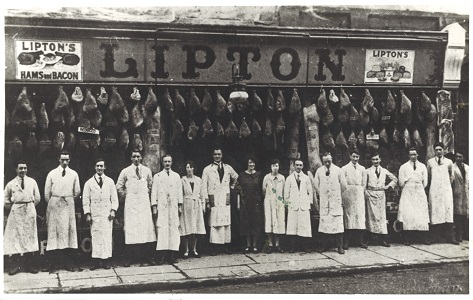
by Tom Kenny
In 1871, Thomas Lipton from Glasgow used his savings to open his first shop. By the 1880’s he had over 200 shops. He was an entrepreneur, and when he realised that there was potential for growth in the market for tea, and that the product was too expensive, he went to Ceylon and bought his own tea plantation. He sold his tea at low prices in one pound packets, half and quarter pound packets and he advertised it very cleverly, “Direct from the Tea Gardens to the Teapot” or “Treat your Lips to a Cup Of Lipton’s Peko Tips Tea, two shillings and eight pence per pound”.
STOP! THIS IS THE BAL

by Tom Kenny
This pub was one of Salthill’s landmarks for over a century. It was a post office originally until Joe Crehan from Ballinasloe bought it at the end of the 19th century and converted it into a pub, grocery and guest house. The name Ballinasloe House was quickly shortened in Salthill to ‘The Bal’. At the time Salthill village ran from here to Seapoint with a few houses further west.
THE ‘GREEN GRASS’ IN THE CLADDAGH
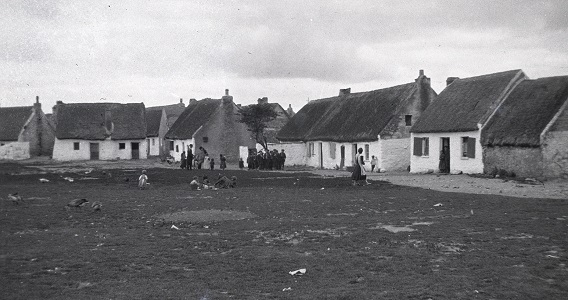
by Tom Kenny
This photograph of ‘The Green Grass’ also known as ‘The Big Grass’ in the Claddagh was taken on the 29th of July 1914. It was taken from roughly where the Claddagh Hall is today. There was a wide expanse of grass off to the left towards where South Park is today. In the early days parts of it were tidal, the tide would come in here in the form of a series of streams. In Peadar O’Dowd’s wonderful book on the Claddagh, there is an image of this area with a very large stream in the foreground. These streams were gradually filled in, thus creating the kind of surface we see in the photograph. There were occasional sandy patches visible on the grass.
EAMONN DEACY PARK
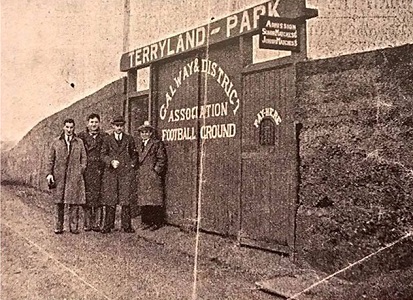
by Tom Kenny
The townland in which this park is situated is known as Terryland or Tirellan, derived from the Irish Tír Oileáin (The Land of the Islands) which was so named because the river divided into many streams thus creating islands in the area. It is in the Civic parish of St. Nicholas in the Barony of Galway.
Historically, the area was famous for Terryland Castle, popularly known as Oldcastle, a strategically important building as it commanded the river at a point where there was a ford. The De Burgh family built the castle in the late 14th or early 15th century to protect the river crossing from the O’Flahertys. It later devolved to the Lynch family. It was occupied by Sir Charles Coote during the Cromwellian campaign. In 1691, there were French Musketeers in residence when it was being attacked by General Ginkel. They abandoned it and set fire to it leaving it in ruins ever since.
THE END OF THE OLD CLADDAGH
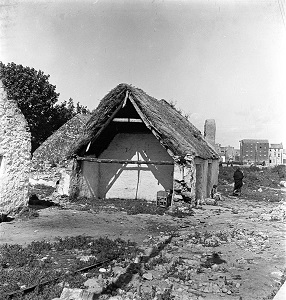
by Tom Kenny
In 1812, there were 468 cabins or houses, all thatched, in the Claddagh. These were occupied by 500 families totalling 1,050 males and 1,286 females. That was a lot of people and houses in a relatively small geographical area and could be described as a “Clachan”, a large irregular group of houses clustered closely together. All of these houses were single storey buildings, only the two-storeyed “Aran View House” and the early 19th century coastguard houses were higher.
PART OF FORSTER STREET, 1905
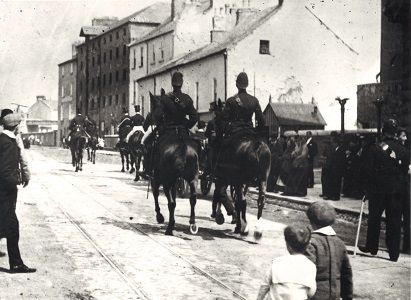
by Tom Kenny
This photograph, taken from an old glass slide, shows some important personage in an escorted carriage leaving the Great Southern Hotel. There are some mounted liveried gentlemen in front and two RIC men on horseback behind the carriage, which is hidden by the RIC men. You can see a policeman on foot to the right of our picture.
The tramlines in the foreground lead to the terminus which was in Forster Street which was named after the Blake-Forsters, an eminent family, several of whom were mayors of Galway. The street was known as Boherbeg (as opposed to Bohermore). It appears on an 1820 Eyre document as ‘The Mail Coach Road’. The small black hut you see on the right was a toll booth, known locally as ‘the custom box’. It was the busiest toll booth in Galway and in the twelve months leading up to May 15th, 1913, the authorities collected £654 – 10 -2 here. They paid out wages of £56-5-6 in that time so the profit to the city was £598-4-8, a lot of money in those times.
SEAMOUNT NURSING HOME
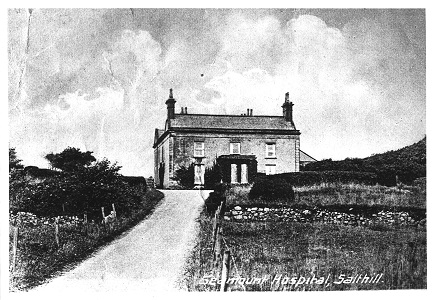
by Tom Kenny
A “To Let” advertisement in a Galway newspaper in April 1860 promoted the fact that Seamount Villa contained a parlour, drawing room, six bedrooms, a kitchen, water closet, a coach house with some stabling and a small garden. The grounds were nicely laid out and had an approach to the sea. George Fallon who lived at ‘The Baths’, Salthill would show the place to prospective customers.
In 1895, the building, which was situated near Blackrock at the end of the promenade, was occupied by Sebastian Nolan who at one time lived at Ballinderry Castle near Tuam. He was an eccentric and cranky man who fell in love with an East Galway girl who shunned him and joined the Mercy Nuns. When he died in 1907, he left some money and property, including Seamount Lodge, to the Mercy Nuns. It was part of Nolan’s will that the produce from his vegetable garden would go to the Magdalen House in Forster Street. Because of some legal difficulties, the nuns were unable to occupy Seamount for some time.
.png)